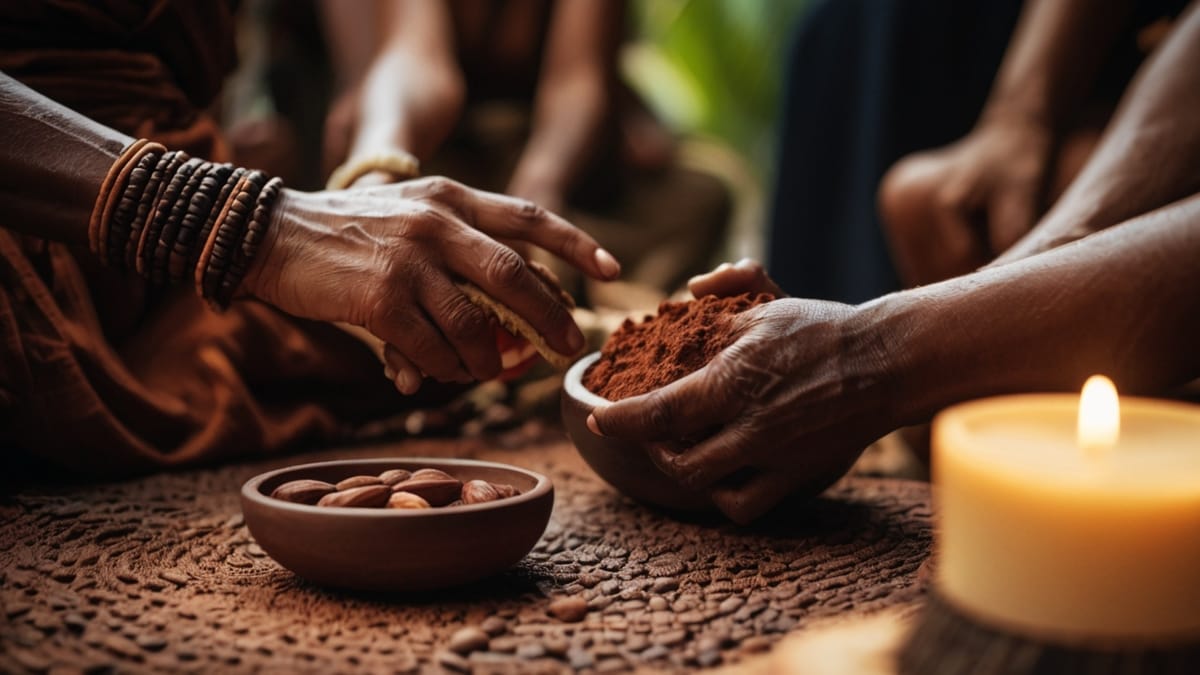A beautiful combination of ancient wisdom, community, and mindful wellness
As we dive into the world of alternative health and wellness practices, one hidden gem shines bright - cacao ceremonies.
Going beyond the widespread coffee scene, the cacao ceremony is catching on due to its special mix of spiritual, nutritional, and cultural elements.
Let's explore this intriguing world some more.
What is the cacao plant?
The cacao plant, or Theobroma cacao, thrives in tropical areas worldwide. It's famous for its seeds, aka cacao beans, which are key to making chocolate. But there's more to this intriguing plant than just its role in our favorite sweet treats.
People have been appreciating cacao for thousands of years. And it has been a part of many different civilizations and cultures.
A short history of cacao use
Throughout history, cacao has been valued for its rich nutrients and various health benefits.
But did you know that the cacao plant is native to the Americas?
It was first cultivated by the ancient Mayans and Aztecs, who held it in high regard for its cultural, ceremonial, and economic significance. Cacao was not just a dietary staple for these civilizations. It was often a significant element of ceremony, trade, and even currency. And it was a symbol of abundance and divinity, deeply intertwined with their religious and social fabric.
Plus, cacao was thought to have mystical properties, with the Mayans and Aztecs linking it to the gods. They often used it in religious rituals and offerings. And only the elite and nobility got to enjoy it.
During the Spanish colonization of the Americas, cacao made its way to Europe. Where it quickly gained popularity among the nobility. It was considered a luxurious indulgence, enjoyed in the form of hot chocolate drinks. The demand for cacao grew, leading to the establishment of cacao plantations in various parts of the world.

And what is a cacao ceremony?
With deep cultural roots, cacao ceremonies are becoming an appealing "alternative" practice in the modern-day wellness repertoire. Harmonizing the physical, mental, and spiritual spheres of life.
But what exactly are cacao ceremonies and why are they gaining popularity?
Cacao ceremonies involve the ceremonial consumption of cacao. Often used in its purest form – a bitter, unprocessed paste made from cacao beans.
Participants drink the cacao in small doses while taking part in guided meditation, intention setting and other rituals. It's meant to be a heart-opening experience that allows for deeper self-awareness, emotional release, and connection with others and nature.
The cultural significance of cacao ceremonies
Cacao ceremonies were integral to Mayan and Aztec cultures, often performed during rituals, celebrations, and pivotal life events. These ceremonies brought communities together, fostering a sense of unity and shared experience. The Mayans believed that cacao had the ability to connect them with the divine and access higher states of consciousness.
Today, this ancient practice is being revived, as people across cultures seek to reconnect with traditional wisdom and practices. The allure of cacao ceremonies lies in their ability to provide a space for individuals to explore their inner selves, find solace, and connect with others in a meaningful way.

How do cacao ceremonies work?
While the specifics can vary depending on the tradition adhered to, a typical cacao ceremony involves:
- Activities like meditation, singing, dancing, or sharing personal stories
- A group of people enjoying cacao in a ritual-like way
- Setting intentions and creating a sacred space
- Preparation of the ceremonial cacao drink
The aim is to set up a space for reflection and connection, using cacao's natural qualities to help create this profound experience.
During the ceremony, participants are encouraged to set intentions for their journey with the cacao. The cacao itself is prepared in a special way, often in the form of a warm drink. And the facilitator of the ceremony guides the participants through various activities. Creating a safe and supportive environment for exploration and self-discovery.
As you consume the cacao, its natural compounds work their magic on the body and mind:
- Theobromine, a stimulant, provides a gentle energy boost
- Phenethylamine, a mood enhancer, promotes feelings of joy and euphoria
- Anandamide (often called the "bliss molecule") is linked to feelings of happiness, love, and general well-being
Combined with the intentional practices of the ceremony, these effects can help you tap into your emotions, release blockages, and gain clarity. This, together with the communal aspect of the ceremony, creates a powerful space for connection and healing.
As cacao ceremonies continue to gain popularity, more people are discovering the transformative power of this ancient practice. Whether seeking personal growth, emotional healing, or simply a deeper connection with others, cacao ceremonies offer a unique and profound experience that taps into the wisdom of the past while embracing the present.
What’s actually the difference between coffee and cacao?
We're all pretty familiar with coffee, a popular pick-me-up around the globe. But how does it stack up against cacao, especially when enjoyed in a ceremonial setting?
The health impacts of coffee vs cacao
While both coffee and cacao contain stimulants, their health impacts differ greatly.
Caffeine, the main kick in coffee, wakes up the nervous system, making us alert. But it can also ramp up anxiety and mess with our sleep patterns.
Cacao is also a stimulant. But it operates more subtly. Promoting feelings of well-being without the jittery side-effects associated with caffeine. Plus, cacao contains a higher concentration of antioxidants and other beneficial compounds.
The ritual experience
Coffee is often seen as a quick fix. Something to grab on the go or sip at our desks while powering through work. While it can certainly be enjoyed with intention, its cultural significance is not usually tied to ceremonial use.
Cacao, however, has deep roots in ceremony and ritual. From preparation to consumption, it's meant to be savored and experienced mindfully. Especially in a ceremonial context, it invites a slower, mindful consumption, enriching the sensory experience. Its role in promoting emotional well-being and facilitating connection also sets it apart from coffee.
Coffee and cacao both offer an energy boost and enjoyment. But they differ in cultural significance, health effects, and overall experience. Whether you're sipping hot cocoa or joining a cacao ceremony, there's no denying the unique power and timeless wisdom of this cherished plant.
How can I participate in a cacao ceremony?
Interested in experiencing a cacao ceremony for yourself? Here's how you can get started:
- Research and find a reputable facilitator or group offering cacao ceremonies in your area
- Prepare yourself for the ceremony: set intentions, create a comfortable space, and follow any pre-ceremony guidelines given by the facilitator
- During the ceremony, be open to the experience and trust in the process. Allow yourself to connect with your emotions, release any blockages, and connect with others.
- Afterwards, take time to reflect on your experience and integrate any insights gained into your daily life.
Before joining a cacao ceremony, it's a good idea to skip food and caffeinated drinks for a few hours. This helps your body absorb the cacao more easily.
What can I expect during a cacao ceremony?
During the ceremony, you can expect to be guided through the consumption of cacao, with opportunities for focused intent, meditation, and sharing experiences with others.
Depending on the ceremony, you may also take part in singing, dancing, and moments of silence. Above all, a cacao ceremony is a personal journey within a communal setting, offering an experience that's unique to every participant.
Beginning: As you settle into the space, the atmosphere typically transforms into one conducive to reflection and connection. Natural elements (e.g., candles, flowers, crystals) might be used to decorate the space, giving the ceremony a sacred vibe. The facilitator will probably start with an introduction, explaining the importance of cacao and what to expect during the session.
First Taste: When the ceremonial cacao is ready, you'll be invited to take your first sip. Usually with a moment of silence or a group affirmation. This first taste helps you connect with the experience on both a physical and emotional level. Throughout the ceremony, the facilitator will guide you in exploring your intentions, with meditative pauses for personal reflection.
Group Sharing: Along with personal reflection, group sharing is often encouraged, building camaraderie and understanding among participants. These interactions can spark powerful insights as stories and emotions connect. Activities like dancing or guided breathing exercises can add energy to the space, creating a lively balance between calm and expression.
Participants often leave empowered, with fresh insights and a renewed sense of connection—not only to themselves but also to the community around them. Each cacao ceremony is unique, promising an enriching experience shaped by the collective energy and intentions of those present.

And how can I experience cacao ceremonies?
Joining a cacao ceremony is a great way to dive deep into the experience, boosting wellness, introspection, and connection with others.
To get the most out of this special practice, here are some tips and guidelines to consider:
- Approach with Intent: Arrive at the ceremony with clear intentions for your experience. Reflect on what you hope to gain, whether it’s emotional healing, personal insight, or connection with the community.
- Create a Mindful Space: Upon entering, take a moment to ground yourself. Acknowledge the significance of the space and the collective energy of the participants.
- Engage with the Ritual: Participate actively in the ceremony. Whether that means sharing stories, singing, or meditating. Embrace the communal atmosphere—this is a shared journey.
- Honor the Cacao: When consuming cacao, take your time to savour the flavours and sensations. Consider the plant's rich history and its role in the ceremony as you enjoy it mindfully.
- Respect the Setting: Similar to a Japanese Zen garden, cacao ceremonies require a respectful attitude. Keep conversations soft, and let each moment unfold naturally. Avoid distractions, focusing instead on the experiences around you.
- Observe and Reflect: After the ceremony, take a moment to contemplate your feelings and insights. Journaling your reflections can be a valuable way to process the experience and integrate it into your life.
By sticking to these guidelines, you can dive into the wonderful ritual of cacao ceremonies, creating a space for growth, connection, and inner peace.
Cacao ceremonies are spreading globally
From its ancient origins in Latin America, cacao ceremonies are spreading across the globe, finding resonance in today’s global wellness culture.
In the realm of modern wellness, cacao ceremonies are seen as a powerful tool for self-exploration and connection. They offer an alternative to more mainstream wellness practices, providing a unique blend of historical and cultural richness, emotional healing, and communal bonding.
As awareness of the benefits of cacao ceremonies continues to grow, the practice is expected to gain increased popularity.
It's not hard to imagine a future where cacao ceremonies are as commonplace as yoga classes or meditation retreats, serving as a refuge from the hustle and bustle of modern life.
P.S. Here's a short film about ceremonial cacao from the perspective of Maya Tzutujil tribe in Guatemala:
A film about ceremonial cacao by Cacao Lab.





Comments ()